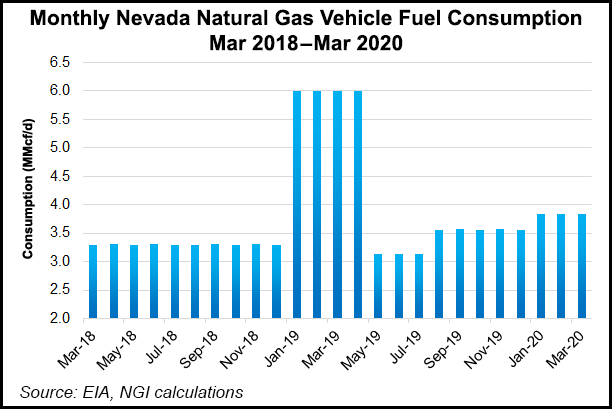Regulatory | NGI All News Access
Nevada ‘Clean Cars’ Program Aims to Boost Low-Emissions Sales
Nevada Gov. Steve Sisolak on Monday introduced a multi-year regulatory effort to promote more low- and zero-emission vehicle sales, including natural gas vehicles (NGV) and the use of renewable natural gas (RNG).

New regulations, targeted for 2024, would be part of the “Clean Cars Nevada,” involving the Nevada Division of Environmental Protection (NDEP) and Department of Motor Vehicles (DMV) that would work to adopt California vehicle standards.
The proposed regulations “aim to reduce both greenhouse gas and pollutant emissions from the fleet of vehicles sold annually by motor vehicle manufacturers in this state,” said Sisolak spokesperson Samantha Thompson.
In April, carbon dioxide (CO2) and fuel efficiency standards were jointly released by the U.S. Environmental Protection Agency and National Highway Traffic Safety Administration, paving the way for wider recognition of natural gas as a viable transportation fuel option.
NDEP’s package of emissions standards if adopted would apply to fleets that could be composed of different technologies, including NGVs using RNG.
“Now more than ever, it is critical for Nevada to continue accelerating efforts to address climate change, including capturing the benefits of sustainable transportation options,” he said.
NDEP through 2021 plans to work with stakeholders on the proposed regulations.
The No. 1 source of emissions in Nevada is from transportation, said director Bradley Crowell of the Nevada Department of Conservation and Natural Resources. “Cleaner cars provide cleaner air and healthier communities.”
In California, Southern California Gas Co. and Pacific Gas and Electric Co. have demonstrated a potential breakthrough electrochemical technology for converting CO2 into raw biogas and eventually pipeline-quality RNG.
The technology was created with startup Opus 12, which developed a “drop-in solution” that reprograms industrial-scale “polymer electrolyte membrane (PEM) water electrolyzers” to split CO2. PEM electrolyzers can be used to produce hydrogen from water and directly integrate with intermittent sources of renewable electricity.
In the demonstration, Opus 12 developed and showed key improvements to its core CO2-to-methane technology in Berkeley, CA. Field trials now are planned.
Also on the technology front, Tesla Inc., General Motors and a Chinese battery manufacturer said they are close to introducing an electric vehicle (EV) battery that would last for one million miles.
In addition, Italy’s Landi Renzo’s U.S. unit has secured certification from the California Air Resources Board for 2020 F-250/350 6.2-liter engines that run on compressed natural gas and RNG.
© 2024 Natural Gas Intelligence. All rights reserved.
ISSN © 1532-1231 | ISSN © 2577-9877 |


